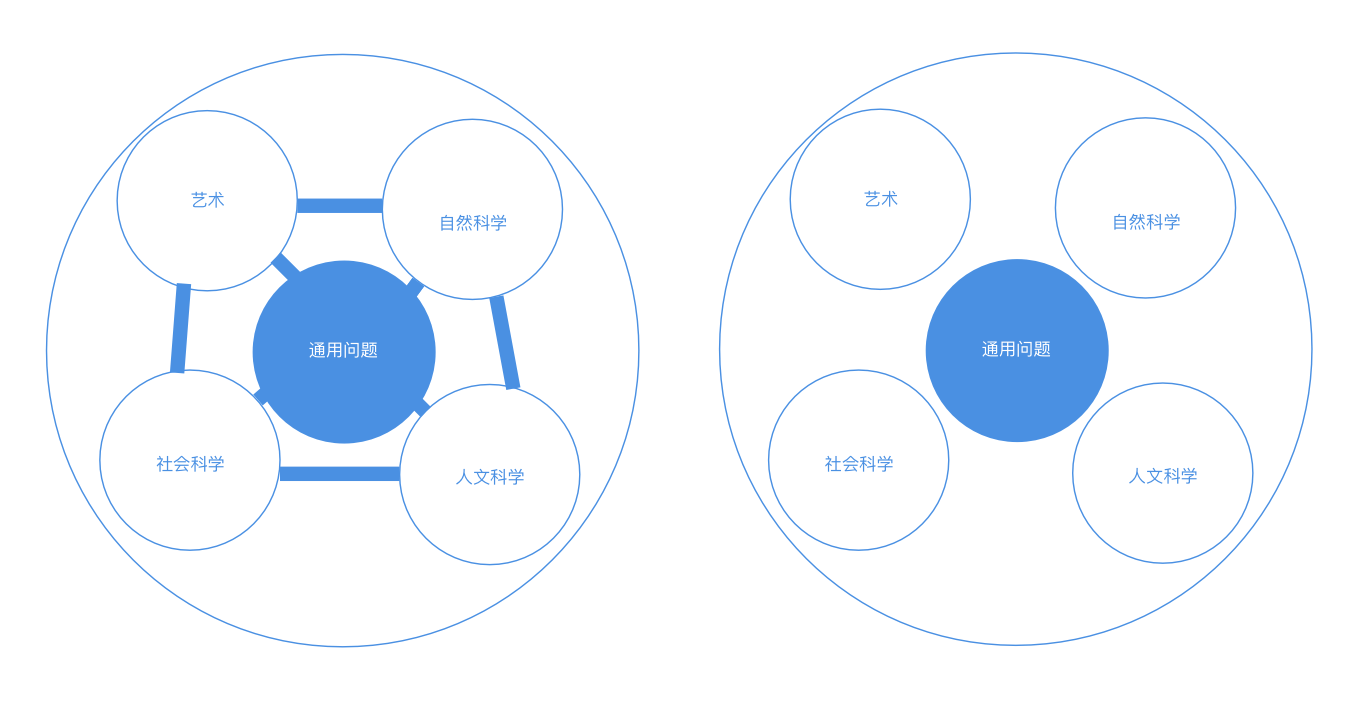Despite efforts to discover the foundations of design thinking in the fine arts, the natural sciences, or most recently, the social sciences, design eludes reduction and remains a surprisingly flexible activity.
尽管人们很努力地发现了设计思维存在于艺术、自然科学和社会科学等学科之中的「地基」,但是设计的灵活性和不确定性并没有因此减少。
:::info
翻译困扰:foundations of …前面用了虽然,说明呈现的是一个好的事情,但是实际现状却不好。
人们希望能够解决设计的不确定性,但是实际上就算发现了设计的地基(不是最关键的,但是是非常重要的),也没法消除这种不确定性。
design eludes reduction 设计避免减少了什么?是设计活动减少?还是设计的灵活性减少?还是设计的什么东西减少?
:::
No single definition of design, or branches of professionalized practice such as industrial or graphic design, adequately covers the diversity of ideas and methods gathered together under the label.
任何一种对设计的定义,或是一个具体的设计领域(如工业设计、平面设计),都没法全面涵盖所有的设计思维和方法。
:::info 工业设计也好,视觉设计也好,在设计学的语境下看,有的问题可能适合用工业设计方法,有的问题可能适用视觉传达的方法,有的问题可能都适用而且都需要。而单一的学科领域的方法并没法解决所有的设计问题。 :::
Indeed, the variety of research reported in conference papers, journal articles, and books suggests that design continues to expand in its meanings and connections, revealing unexpected dimensions in practice as well as understanding.
事实上,在会议论文、期刊文章和书籍中报道的各种研究表明,「设计」在不停地扩大自己的内涵,与其他学科建立更多联系,并在这个过程中揭示出实践中不曾预期的维度信息和认知。
revealing 是一个动名词,表示一个伴随状态。
This follows the trend of design thinking in the twentieth century, for we have seen design grow from a trade activity to a segmented profession to a field for technical research and to what now should be recognized as a new liberal art of technological culture.
二十世纪设计思维的趋势正是如此,因为我们已经见证了设计从一个细分行业的贸易活动发展到了研究技术的领域,如今更是变成了一种科技文化下的新博雅学科。
It may seem unusual to talk about design as a liberal art, particularly when many people are accustomed to identifying the liberal arts with the traditional “arts and sciences” that are institutionalized in colleges and universities.
把设计作为一门博雅学科来谈论似乎非常罕见,尤其是还有很多人习惯用学院式的方式把博雅学科视为传统科学艺术。
But the liberal arts are undergoing a revolutionary transformation in twentieth-century culture, and design is one of the areas in which this transformation is strikingly evident.
但博雅学科正在经历二十世纪文化(科技文化)的革命性转变,而设计正是这种转变特别明显的领域之一。 :::info 科技文化在另一个程度上也影响了博雅学科? :::
To understand the change that is now underway, it is important to recognize that what are commonly regarded as the liberal arts today are not outside of history.
为了理解现在正在发生的改变,知道如今的博雅学科的内容并不是什么新东西是非常重要的。
They originated in the Renaissance and underwent prolonged development that culminated in the nineteenth century as a vision of an encyclopedic education of beaux arts, belles lettres, history, various natural sciences and mathematics, philosophy, and the fledgling social sciences.
博雅学科(在这句里更适合称为博雅教育)起源于文艺复兴时期,经历了漫长的发展,最终在19世纪达到了一个极致,成为了一套广博的教育体系,其包含了艺术、文学、历史、各种自然科学、数学、哲学,以及那个时候刚刚兴起的社会科学。
This circle of learning was divided into particular subject matters, each with a proper method or set of methods suitable to its exploration.
它的知识领域被分成了一些特定的主题,每个主题都有一个或者一套适当的、适合于其探索的方法。
At their peak as liberal arts, these subject matters provided an integrated understanding of human experience and the array of available knowledge.
在博雅学科发展的鼎盛时期,这些主题能够基于已有知识与人类经验获得一个全面的认知。
为什么这边把知识与经验分开提?原因是知识是已经被抽象总结了的,是一类显性的信息,而经验则是一种隐藏着的还没有办法被提炼的,算是隐性信息。这句话的意思则是这些主题能够整合显性与隐性的信息来获得一个完整而全面的理解认知。
By the end of the nineteenth century, however, existing subjects were explored with progressively more refined methods, and new subjects were added to accord with advances in knowledge.
然而到了十九世纪末,人们用更加精细的方法来探索已有的主题,新的主题随着知识的进步也越来多。
As a result, the circle of learning was further divided and subdivided,until all that remained was a patchwork quilt of specializations.
结果,整个知识领域被进一步划分和细分,直到其变成一个一堆细分领域「拼凑」而成的“碎布床单”。
:::info a patchwork quilt 的意思是「用小块布缝缀的被罩」。
这里将细分后的专业领域知识比作是“小块布”,整个知识领域比作“床单”。能够直观感受到,这种床单并不讨人喜欢,因为有着太多的缝合线。完全不如用几块大的布整体制成的床单。这和博雅学科面临的情况十分像。博雅学科在19世纪达到巅峰,应该是指那个时期的学科知识「刚刚好」,分化也还没有那么严重,所以每个人都能够对这些学科有个非常全面而整体的认知理解,不至于陷到细节里面。而随着知识领域的划分,对于整体的把握就变得十分困难了。 :::
Today, these subject matters retain an echo of their old status as liberal arts, but they flourish as specialized studies, leading to the perception of an ever more rich and detailed array of facts and values.
如今,这些主题保留了旧时博雅学科的身份,但他们实际上却是以细分领域的形式蓬勃发展,并使得人们对这些领域下的客观事实和它们的价值有了更加丰富和细致的感知。
:::info
an echo of their old status as liberal arts echo 有“回声、回想、重复”这样的意思,这个词组的直译是“旧时博雅学科身份的回声/重复”,从理解上就是说旧时身份的复现,在这里意译为 「保留了旧时博雅学科的身份」。这句话阐述了如今学科的发展模式的差异,虽然还披着旧时博雅学科的“皮”,但是本质上却是在用细分领域研究方法进行研究。结果上就使得这些学科在探索中获得了非常丰富而细节的知识。
举个例子,杨志平在快速写作模式谈)中分析了写作的道与术。
“中国近代以后落后于西方,很大程度,是我们的文化中充斥着大量不可言说的”道”。一旦探讨写作的具体技巧与指导性、应用性强的术,往往被讥笑。最后,写作的道始终掌握在那些文人手中,站在一个云端来俯视与鄙视那些在金线之下挣扎的百姓们。”
“ 但是,真的有必要再使用白首穷经这类低效的写作学习方式吗?西方通过创意写作、分析性写作、有效商务写作、写作QA站点等课程走上了另一条不同的道路。”
用这个例子来解释,对于写作这个主题来说,传统的博雅学科就是研究「道」的问题,而现在变了本质之后则是开始研究「术」的问题,虽然获得了大量丰富而细节的知识,但是道就变得不那么重要了。最后的结果就是变得太碎,失去了全局观。 :::
Although these subjects contribute to the advance of knowledge, they also contribute to its fragmentation, as they have become progressively narrow in scope, more numerous, and have lost “connection with each other and with the common problems and matters of daily life from which they select aspects for precise methodological analysis”.
虽然这些主题有助于知识的进步,但是它们也造成了主题之间的脱节。因为专业知识涉及的范围越来越多,越来越细,这使得它们失去了各个主题本身之间联系,同时这也切断了它们与各种现实中一般问题与事物之间的联系。而事实上,各个主题本该用精确的方法去分析这些一般问题的各个方面。
:::info 前面一句话相对好理解,但是后面一句话可能会让人觉得有点难。将专业领域细分之后带来的问题是除了主题本身的脱节,也与与一般问题脱节了。这个应该是对博雅学科的理解上存在偏差。我们可能认为博雅学科不过是一堆细分学科的合集,但是根据作者的意思来看并不是这样。实际上应该是下图左边的模式。 :::
 :::info
可以注意到博雅学科的中心,或者说聚焦的关键是一般问题,而各个主题从一般问题出发衍生自己主题的知识,并在主题之间互相交叉。但是如果将主题细分了,除了主题本身之间没了联系,主题与一般问题之间的联系也被斩断了。变成了上图右边那样。
:::info
可以注意到博雅学科的中心,或者说聚焦的关键是一般问题,而各个主题从一般问题出发衍生自己主题的知识,并在主题之间互相交叉。但是如果将主题细分了,除了主题本身之间没了联系,主题与一般问题之间的联系也被斩断了。变成了上图右边那样。
但是我觉得最困难的一句理解是from which they select aspects for precise methodological analysis。这个 From which 的对象是什么?
他们从()中选择方面/面貌来用精细的方法进行分析。
可以感受到的意思是他们从()的一个方面进行精细化分析。那这个 From Which 的对象是一般问题吗?
感觉不是,如果是一般问题,那就不会有用精确分析的方法。因为如今现有的主题已经和这个一般问题脱节了。而过去的主题是不会用精确分析的方法的。
不对,应该就是一般问题,句子逻辑是这样的:他们本该从一般问题去分析,但是现在这个关联被打断了。
:::
The search for new integrative disciplines to complement the arts and sciences has become one of the central themes of intellectual and practical life in the twentieth century.
寻找新的综合学科来补充旧时博雅学科(科学艺术)的地位,已成为二十世纪理论和实践的中心课题之一。
:::info discipline 作为学科的翻译可能更为合适。intellectual and practical life 我翻译为理论和实践。intellectual 意思是”智力的“,practical 意思是”实践的“,这是两个相对的词汇,同时拿来形容 life 的话可以感受到应该是同一个 life 的两个方面,因此理论和实践的意译会比较合理。 :::
Without integrative disciplines of understanding, communication, and action, there is little hope of sensibly extending knowledge beyond the library or laboratory in order to serve the purpose of enriching human life.
如果没有一个综合理解、交流和行为的学科,就不可能合理地去探索未知的知识来丰富人类生活。
The emergence of design thinking in the twentieth century is important in this context.
在这一背景下,二十世纪中设计思维的出现是很重要的。
The significance of seeking a scientific basis for design does not lie in the likelihood of reducing design to one or another of the sciences-an extension of the neo-positivist project and still presented in these terms by some design theorists.
我们为设计寻求科学基础不是为了将设计局限进某种科学定义(不过目前仍然有一些设计理论家用这样的方式来圈定设计的内涵,这就相当于一种新实证主义的解释了)。
逻辑实证主义和逻辑经验主义,共同形成了新实证主义,也被称为科学经验主义。新实证主义者的研究兴趣在于对科学的整合和统一,以及对科学方法的正确描绘。
Rather, it lies in a concern to connect and integrate useful knowledge from the arts and sciences alike, but in ways that are suited to the problems and purposes of the present.
恰恰相反,我们这么做的意义在于连接和整合如同博雅学科中的一些有用的知识。不过和旧博雅学科的区别在于,这些知识是适用如今存在的各种问题和目的。
Designers, are exploring concrete integrations of knowledge that will combine theory with practice for new productive purposes, and this is the reason why we turn to design thinking for insight into the new liberal arts of technological culture.
设计师们如今正在探索知识的具体整合形式,因为这种整合能够把理论与实践结合起来达到创新的目的。这就是为什么我们开始研究设计思维,以求洞察设计这门科技文化下的新博雅学科。
turn to 有 ”转向, 变成, 求助于, 起劲地开始行动“的意思。这里是指研究者把目光转向了设计思维,希望能够通过研究清楚设计的思想来洞察设计这门新博雅学科。

